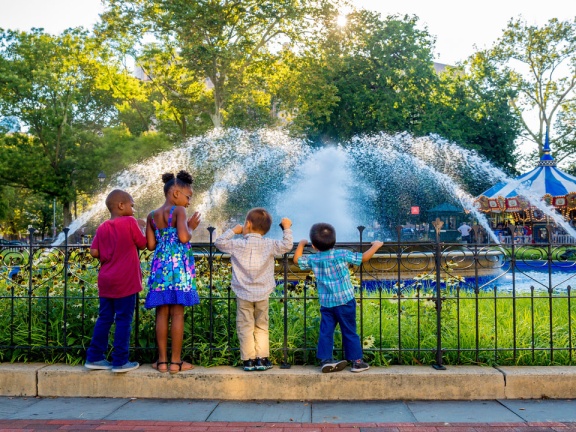
Background
A well-funded, well-maintained, and actively programmed parks and recreation system contributes to the quality of life of all Philadelphians. It contributes to the environmental, social, and economic health of our city.
One measure of the strength of a city’s parks and recreation system is the ParkScore®, published annually by the Trust for Public Land (TPL). ParkScore is a comprehensive measure of the 100 most populous U.S. cities’ urban parks systems. TPL and the ParkScore evaluate cities’ parks systems based on five key criteria: access, equity, acreage, investment, and amenities. The score provides a standardized 0–100 ranking that allows for comparison and highlights strengths and gaps in public park access and quality. ParkScore reflects not just the quantity of parks, but also their distribution, quality, and equity of access. A higher ParkScore signals that a city is investing in public well-being, resilience, and community development — making it a valuable benchmark for policymakers, planners, and residents.
In addition to objectives focused on improving parks and public spaces, expanding programming in parks and other outdoor spaces, and increasing the number of urban trees, WPF has identified investment in parks as a key objective to improve residents’ environments. We are using one of the calculations provided by ParkScore as a consistent, transparent, and publicly accessible metric of progress on this objective. To calculate total investment, ParkScore aggregates spending for publicly accessible parks and recreation facilities across all public agencies and private organizations, including monetized volunteer hours. To minimize the effect of annual fluctuations, investment in parks is reported as a three-year average based on the three most recently finalized fiscal years.
The Foundation’s current objective focused on increasing investment in parks was announced in 2024 and is based on the 2024 ParkScore, in which Philadelphia's park system was ranked 32nd nationally, earning a score of 57.5 out of 100. The city excelled in park access, with 95% of residents living within a 10-minute walk to a park. However, it lagged in investment, spending approximately $86 per capita, below the national average of $124. For comparison, Washington, D.C., which ranked first in park system quality, spent $284 per person in 2024.
By 2025, Philadelphia improved its standing in the ParkScore ranking to 28th place, with a score of 63.1, and per capita investment of $112. Investments through the Rebuild initiative, the addition of amenities like recreation centers and splash pads, and growth in the percentage of residents with nearby park access all contributed to the increased score.
The progress from 2024 to 2025 highlights Philadelphia's commitment to enhancing its parks and recreation system, focusing on increased investment and accessibility. Park advocates argue that increased support, whether through dedicated city allocations, public-private partnerships, volunteerism, or innovative financing mechanisms, is critical to ensuring that all neighborhoods, particularly those historically underserved, have access to safe, well-maintained, and vibrant green spaces. As improvements continue to be made, the Foundation will likely set a new target to pursue over the next ten years. Regardless of the specific dollar figure that is identified, the Foundation will continue to support efforts to increase sustainable investment in our parks system.
Opportunity Overview
The Foundation seeks to support efforts that will increase investment in Philadelphia’s parks and recreation facilities. Proposals can include efforts to increase investment from public or private sources, develop or strengthen innovative community initiatives, expand volunteer efforts, or other projects that are likely to yield increased sustainable investments in our parks and recreation sites. Funding can support system-wide applied research, capacity building, communications, advocacy, coalition building, and other appropriate activities. Projects can focus on individual sites or across the entire parks and recreation system.
We are requesting proposals for one- to two-year projects. After reviewing proposals, WPF will conduct site visits and gather additional information from a limited number of organizations.
Organizations that propose projects in partnership with other applicants will be considered on their individual merits. However, the Foundation recognizes that making significant progress on the objective is difficult and encourages organizations to include partnerships that leverage complementary strengths, resources, and expertise to reach proposed goals.
The Foundation recognizes that there are many different tactics or approaches that could be used to advance the objective stated above. It is our aim to fund projects that have results that can be sustained over time. We are especially eager to see proposals for projects that draw in new public and private constituents, employ new or innovative funding strategies, and/or target areas of the system or city that have been chronically under resourced. All proposals that meet the criteria described below are encouraged.
WPF has $2.5 million available to advance this objective through this RFP. WPF values diverse approaches from various organizations and communities to address the objective, and we aim to attract and fund a range of projects. There is no minimum or maximum amount of funding that projects may request. The grant amount requested should be commensurate with the contribution that the project will make to the overall objective.
Full Request for Proposals (RFP) and Application
Download the full RFP packet for more information about this opportunity including eligibility, review criteria, learning and insights, budget, and link to an application template.
All applications must be submitted through the Grants Portal.
Webinar
An optional informational webinar took place on June 24: